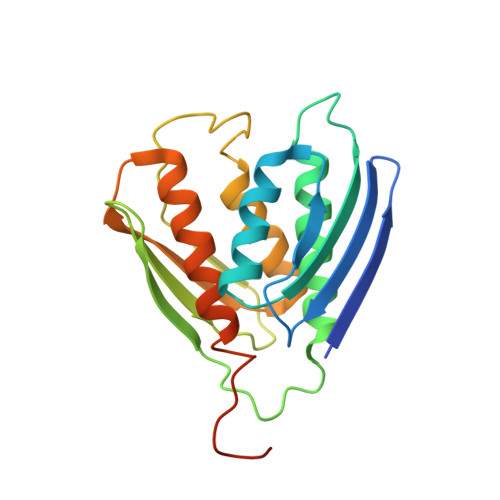Elucidating the structural basis for differing enzyme inhibitor potency by cryo-EM.
Rawson, S., Bisson, C., Hurdiss, D.L., Fazal, A., McPhillie, M.J., Sedelnikova, S.E., Baker, P.J., Rice, D.W., Muench, S.P.(2018) Proc Natl Acad Sci U S A 115: 1795-1800
- PubMed: 29434040
- DOI: https://doi.org/10.1073/pnas.1708839115
- Primary Citation of Related Structures:
6EZJ, 6EZM - PubMed Abstract:
Histidine biosynthesis is an essential process in plants and microorganisms, making it an attractive target for the development of herbicides and antibacterial agents. Imidazoleglycerol-phosphate dehydratase (IGPD), a key enzyme within this pathway, has been biochemically characterized in both Saccharomyces cerevisiae ( Sc_ IGPD) and Arabidopsis thaliana ( At_ IGPD). The plant enzyme, having been the focus of in-depth structural analysis as part of an inhibitor development program, has revealed details about the reaction mechanism of IGPD, whereas the yeast enzyme has proven intractable to crystallography studies. The structure-activity relationship of potent triazole-phosphonate inhibitors of IGPD has been determined in both homologs, revealing that the lead inhibitor (C348) is an order of magnitude more potent against Sc_ IGPD than At_ IGPD; however, the molecular basis of this difference has not been established. Here we have used single-particle electron microscopy (EM) to study structural differences between the At and Sc_ IGPD homologs, which could influence the difference in inhibitor potency. The resulting EM maps at ∼3 Å are sufficient to de novo build the protein structure and identify the inhibitor binding site, which has been validated against the crystal structure of the At_ IGPD/C348 complex. The structure of Sc _IGPD reveals that a 24-amino acid insertion forms an extended loop region on the enzyme surface that lies adjacent to the active site, forming interactions with the substrate/inhibitor binding loop that may influence inhibitor potency. Overall, this study provides insights into the IGPD family and demonstrates the power of using an EM approach to study inhibitor binding.
Organizational Affiliation:
School of Biomedical Sciences, Faculty of Biological Sciences, University of Leeds, LS2 9JT Leeds, United Kingdom.
















